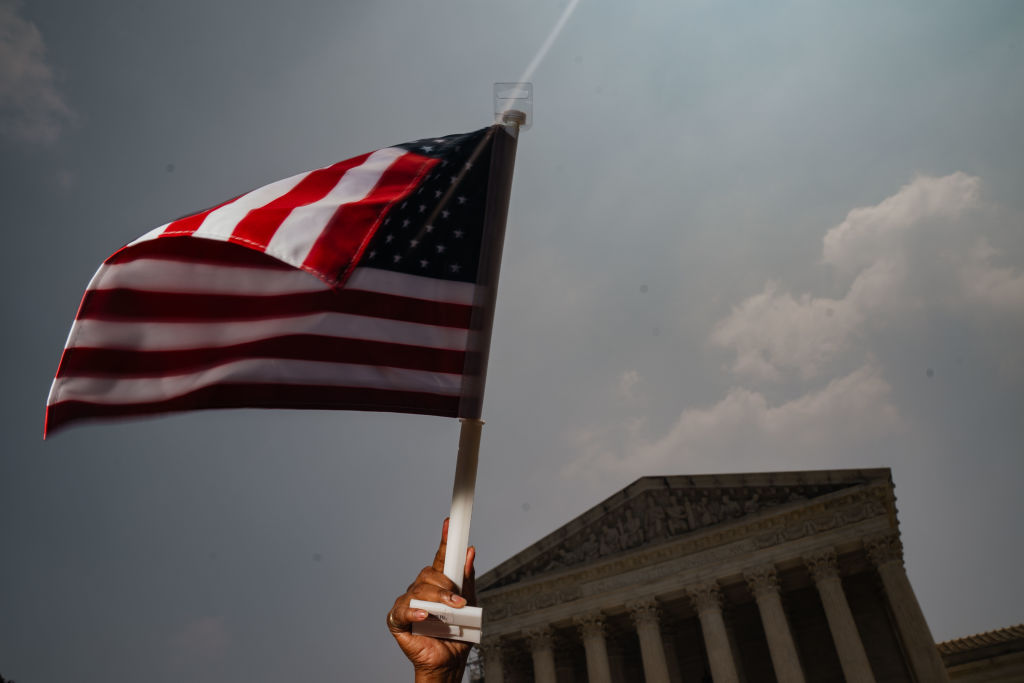Senate Democrats must stay focused on judicial confirmations—but it’s not enough to confirm nominees only to seats that exist. We need to expand the courts.

For progressive court watchers and advocates of judicial reform, Majority Leader Chuck Schumer’s post-Thanksgiving letter was both frustrating (it’s long overdue) and welcome. In it, Schumer urged colleagues to treat judicial nominations as a priority and to prepare “to stay in Washington until we finish our work.” The Senate’s set to leave for the year on Dec. 15.
If they’re truly intent on even coming close to matching former President Donald Trump and Sen. Mitch McConnell’s record on judicial nominations, Schumer and Senate Judiciary Committee Chair Dick Durbin need to hustle. About a week before the Senate’s exit, Democrats’ judicial confirmation ambitions are lofty but not impossible. Trump had confirmed 187 judges by the end of 2019. President Joe Biden had secured 153 as of Thanksgiving.
The Biden administration and Senate allies have already done the hardest part: negotiating with obstructionist Senate opponents over the past weeks and months, to secure support for diverse and highly qualified nominees in red and purple states. Since Democrats have the votes to confirm nominees along party lines, all that’s left is for senators to commit to longer hours in the days ahead.
More than a dozen judicial nominees are on the Senate’s executive calendar already. Seven nominees are awaiting a hearing before the Senate Judiciary Committee, but six are just waiting to be voted out of committee. If Durbin fast-tracks those six to the floor and the Senate stays in late to vote on judicial nominations, then the Senate can confirm these nominees before leaving for the holidays and come very close to matching Trump and McConnell’s numbers from 2019. While not inconceivable, it will take significant clout, will, and leadership to see these confirmations through before Congress departs for the year.
The excessively politicized confirmation process is not the only or even the biggest problem the federal judiciary faces. Across the country, federal courts carry overwhelming backlogs that are de facto deferring or denying justice to thousands of people.
When federal courts can’t keep up with caseloads, parties who require a federal forum to redress wrongs, vindicate their rights, or fight an injustice as a matter of jurisdiction are harmed—sometimes profoundly. Plaintiffs and defendants alike accept compromises and sacrifices they should never have to entertain. A prime example from the civil system is arbitration. Proceedings before arbiters rather than judges and juries favor so-called “repeat players,” i.e., corporations and other deep-pocketed parties, who, accordingly, vocally advocate for arbitration as a solution to the backlog. Even when arbitration yields a just result, it does not create precedent that will help others facing the same issues in the future.
If Biden catches up to Trump on judicial nominations, that’s a start. But the executive branch has much more work to do.
At present, there are nearly 100 judicial vacancies for lifetime federal appointments—and President Biden has yet to name a nominee for 60 of those, including two appellate seats. The legislative branch must likewise revisit its obligations to the judiciary.
It’s not enough to confirm nominees to the seats that exist; we need to expand the courts.
The Case for Expanding the Federal Judiciary
The math is so basic even lawyers get it: We have too many cases and too few judges.
The federal civil system is especially overloaded.
- In 2020, the first year of the pandemic, there were 397,492 pending cases.
- Come 2021, that number rose to 590,288.
As of 2023, lower court expansion has attracted new interest and growing support, for good reason.
The Judicial Conference of the United States this year recommended Congress create two new circuit court judgeships and 66 new district court judgeships, as well as converting seven of the 10 current temporary district judgeships into permanent positions and extending others by five years. This year’s report represented a retreat from a prior recommendation for court expansion, likely a reflection of politics—the hope that a proposal to add fewer judges would be more viable—as opposed to reduced need.
The Conference’s recommendation could have been a foundation for bipartisan cooperation to alleviate the crush our federal judiciary faces. Instead, Republicans co-opted the Judicial Conference’s recommendations with the aim of engrafting new structural advantages. Republican senators from Ninth Circuit states banded together to propose legislation incorporating the Judicial Conference’s expansion recommendations contingent on splitting the Ninth Circuit to the advantage of conservative judicial activists.
Conservatives have long sought to split up the Ninth Circuit. Just ask Donald Trump. The caseload of the sprawling Ninth Circuit, which includes Alaska, Arizona, California, Guam, Hawaii, Idaho, Montana, Nevada, the Northern Mariana Islands, Oregon and Washington, has been the subject of controversy for years. Republicans have at intervals proposed to “solve” the overload by splitting up the states along party lines, a form of judicial gerrymander.
If Republicans aren’t rabidly promoting their plan to split the Ninth Circuit now, it’s because Trump and McConnell did much to make it moot: The duo planted 10 judges on the Ninth Circuit, representing more than a third of that circuit’s active judgeships.
Even lawyers get it: We have too many cases and too few judges.
The Cost of Delay and the Urgency of Expansion
Only by expanding the courts can we ensure the judicial branch can perform its vital role in our democracy and meaningfully increase access to justice.
It would also accomplish a third, complementary aim: mitigating the hyper-politicization of the judiciary by Republicans. The radicalization of our courts, an achievement Trump and McConnell prided themselves on, didn’t just push the courts to the right—it demolished public faith in the justice system and compromised that branch’s ability to function.
Trump racked up 234 total lifetime judicial confirmations with the help of Republicans, led by McConnell, who hadn’t just been waiting for vacancies to arise under a Republican president but had refused to allow Democrats to fill vacancies during the Obama years—most notably the seat that should have been held by now-Attorney General Merrick Garland on the Supreme Court—against Senate rules and custom.
Ergo, Republicans weren’t just filling, but backfilling vacancies.
And instead of adding impartial jurists who’d strengthen the judiciary by increasing its capacity to hear cases, they seeded the judiciary with unqualified ideologues, choreographing the confirmation of young nominees with far-right views but little relevant experience into lifetime appointments.
The ideological and experiential imbalance that Trump and McConnell relished creating has damaged public faith in the judiciary and the courts’ ability to function. The far-right takeover transformed the judiciary from an independent branch of government essential to our democracy into a destabilizing element. The public’s trust in the Supreme Court has hit a historic low.
All the while Trump’s extremist judges, like U.S. District Court Judge Matthew Kacsmaryk in the Northern District of Texas, are tanking faith even in lower federal courts—usually well off the public’s radar.
The radicalization of our courts … demolished public faith in the justice system and compromised that branch’s ability to function.
There are 94 federal district courts. Of those, 55 have sub-divided their jurisdictions into “mini district courts … each with its own judges.” According to a report from the American Bar Association, as many as 35 of those 55 courts have created jurisdictions with just two judges—or, as in Kacsmaryk’s case, a single judge.
These federal judicial deserts contribute to the backlog. They also allow far-right legal activists to judge-shop, filing test cases of national import in districts like the Northern District of Texas, banking on its single judge to break with precedent to achieve political aims—as Kacsmaryck did in the infamous mifepristone case.
The Senate doesn’t just need to fill every vacancy: Legislators need to expand the judiciary for the sake of the people it serves and our democracy.
Looking Ahead
It’s been more than 30 years since Congress did anything to alleviate the caseload crowding the courts created by Article III of the U.S. Constitution. That includes the 94 district courts, which hear trials, and 12 circuit courts, which handle appeals. This ecosystem is comprised of 179 federal appellate judgeships and 673 district court judgeships. For context, the population of the United States grew from 249,000,000 to 340,000,000 (around 37 percent) over the past three decades.
Court expansion isn’t novel or extreme; it’s overdue. Adding seats to ensure federal courts could keep up with the caseload was the norm until President Bill Clinton took office.
The last time Congress acted to provide respite to the courts was in 1990, via the Judicial Improvements Act. The legislation created 11 circuit and 61 district judgeships across the country and enacted guardrails to streamline case management. The significance of the former measure far exceeded the latter because Article III judges have lifetime appointments, making them all but immune to meaningful outside oversight or intervention. It also added a necessary but insufficient stopgap: 13 temporary judgeships, each lasting five years.
More than three decades later, the federal judiciary remains overburdened and faces new challenges. When the pandemic hit, the Judicial Conference had to adapt, anticipating that the already enormous backlog of cases would explode, delaying or entirely deferring justice for thousands of people. Only because the number of cases brought by prosecutors and litigants in civil proceedings fell did the worst prognostications not come to pass. Of course, state, local and municipal courts were hit harder by COVID and the lingering effects of the pandemic on these institutions may yet drive litigants to seek resolution through the federal judicial system instead.
Adding seats to ensure federal courts could keep up with the caseload was the norm until President Bill Clinton took office.
What would a real solution look like? Some version of Rep. Hank Johnson (D-Ga.)’s District Court Judgeships Act, perhaps. Johnson held a hearing in 2021 as the pandemic strained the judiciary, interviewing judges about the dangers presented by continuing to overburden district courts. He then applied the original threshold for case filings per district court judge—a staggering 400, lest it seem judges are simply slacking—to current data from the Judicial Conference to propose 203 new district court judgeships across 47 jurisdictions. Applying the same principle to circuit courts reveals the need for dozens of additional appellate seats.
Urging President Biden, Senator Schumer, and Senator Durbin to match Trump’s judicial confirmations makes for a good rallying cry. Celebrating their historic and terrific strides on professional and demographic diversity, toward a judiciary that resembles the people it serves, is more than justified. Yet more is needed: We must expand the federal courts.
Up next:
U.S. democracy is at a dangerous inflection point—from the demise of abortion rights, to a lack of pay equity and parental leave, to skyrocketing maternal mortality, and attacks on trans health. Left unchecked, these crises will lead to wider gaps in political participation and representation. For 50 years, Ms. has been forging feminist journalism—reporting, rebelling and truth-telling from the front-lines, championing the Equal Rights Amendment, and centering the stories of those most impacted. With all that’s at stake for equality, we are redoubling our commitment for the next 50 years. In turn, we need your help, Support Ms. today with a donation—any amount that is meaningful to you. For as little as $5 each month, you’ll receive the print magazine along with our e-newsletters, action alerts, and invitations to Ms. Studios events and podcasts. We are grateful for your loyalty and ferocity.





